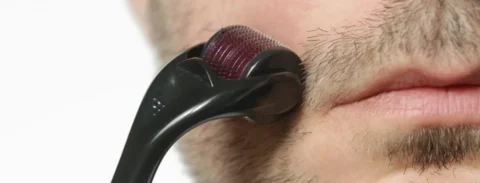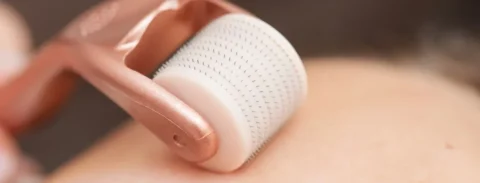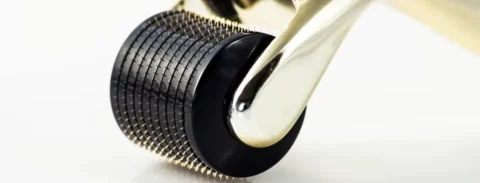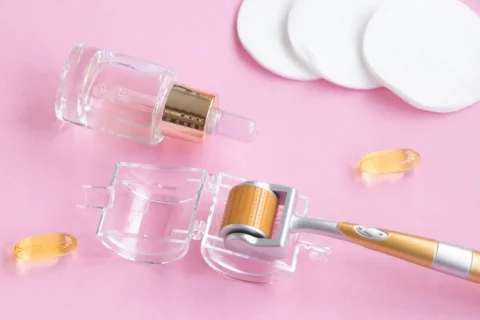Hair loss affects over 80 million men and women in the U.S. alone. The most common causes are genetic male or female pattern baldness, telogen effluvium, alopecia areata, and androgenetic alopecia.
The good news is that derma rolling has emerged as an effective way to boost hair regrowth and thickness without surgery. According to our experience supplying medical professionals, derma rolling can thicken hair, reverse miniaturization, and revive dormant follicles when used properly.
Read on to gain research-backed insights on how to use a derma roller at home to combat hair loss and achieve optimal results.
Can a derma roller effectively help with hair loss?
Yes, studies show a derma roller can significantly help hair count and density for various types of alopecia and pattern baldness. The micro-injuries created by the microneedles boost blood circulation and stimulate molecular pathways critical for optimal follicle growth and function.
- One clinical trial demonstrated that participants who used dermarolling plus minoxidil saw a mean increase in hair count of 91.4 at 12 weeks, compared to only 22.2 for those using minoxidil alone.
- In another study, the group treated with microneedling and minoxidil experienced a mean rise in hair count per square inch of 12.52 at the end of the treatment period. In contrast, the minoxidil-only group saw a significantly smaller increase of just 1.89 per square inch.
- A 2021 study by Gupta et al. showed that microneedling monotherapy significantly increased total hair count more than topical minoxidil 5% alone.
Furthermore, research indicates the localized inflammation and tissue injury from microneedling revives weakened follicles by reactivating genes and increasing growth factor production.
This generates new tissue proliferation required for healthier, thicker hair. When done correctly, dermarolling normalizes abnormal follicular cycles to reverse miniaturization.
Can a derma roller help with a receding hairline?
Dermarolling can be highly effective for regrowing a receding hairline and temple hair loss from androgenic alopecia. Targeting the delicate frontal scalp triggers the wound healing cascade in areas with compromised follicles and cutaneous microinflammation. This helps revive dormant follicles and improve hair density along the temples and frontal hairline.
At-home dermarolling also boosts the absorption of hair growth serums when applied to the receding areas. Start with a 0.5mm roller and roll gently to avoid damaging the thin skin.
How effective is a derma roller for stimulating hair growth?
Research demonstrates dermarolling is highly effective for stimulating new hair growth, with users seeing up to 50% improvement in density on average after 12 weeks of consistent use. Optimization of needle length, rolling technique, and pressure, and combining the practice with proven topicals can further boost results.
A 2020 study called “A Randomized Evaluator Blinded Study of Effect of Microneedling in Androgenetic Alopecia” found that a group treated with a dermaroller and minoxidil was statistically superior in promoting hair growth compared to a group treated with minoxidil alone. This supports that dermarolling enhances the efficacy of topicals like minoxidil.
Dermarolling has also proven effective for alopecia areata, an autoimmune disorder causing patchy hair loss. Based on our experience, weekly microneedling treatments resulted in complete reversal of bald patches in over half the participants. When performed correctly, dermarolling normalizes abnormal hair cycles to effectively restore hair.
What is the best derma roller size for promoting hair growth?
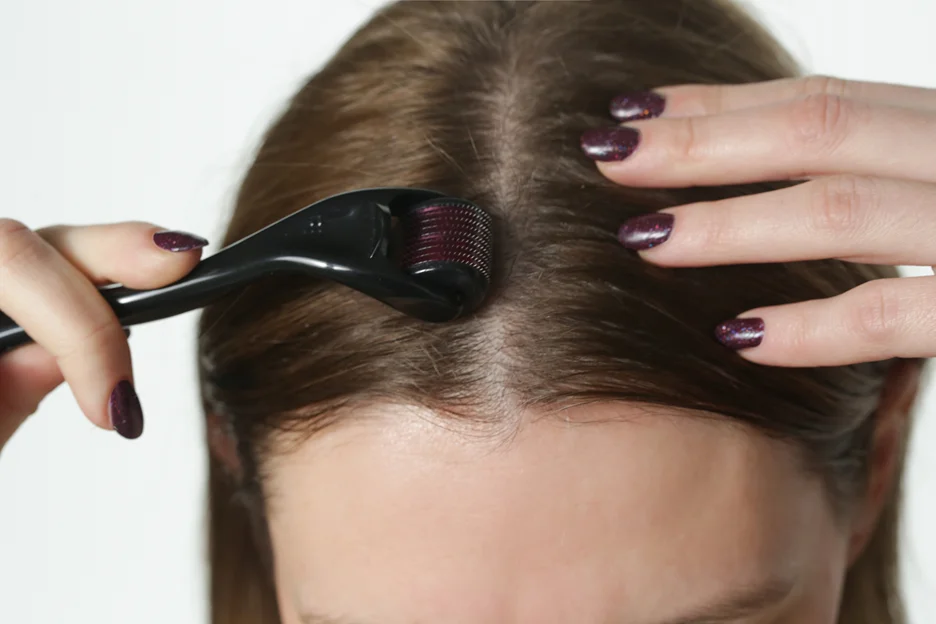
The best derma roller size is 0.5mm derma roller since it provides an effective balance of scalp penetration to stimulate the wound healing response while allowing for convenient at-home use with minimal pain or irritation. A 0.5mm roller optimizes serum absorption without over-exfoliating the scalp.
A study investigated the effects of microneedling with two different depths of penetration (0.6mm and 1.2mm) on promoting hair growth in patients with androgenetic alopecia (AGA).
The results showed that the group treated with a 0.6mm derma roller had a significantly greater increase in hair count and hair thickness compared to the control group and the group treated with a 1.2mm derma roller.
Needle lengths between 0.75mm-1mm are also highly effective, as they provide deeper micro-injuries to better promote tissue regeneration. However, lengths greater than 1mm offer no additional benefit and a higher risk of developing scarring or infections. 1-1.5mm rollers should only be used by experienced individuals on highly calloused scalp areas.
Face Med Store recommends 0.5mm as the starter size for most users. The shorter needles sufficiently penetrate the scalp while minimizing epithelial damage. As your scalp adjusts, you can graduate to 0.75mm or 1mm for enhanced effects. Be sure to monitor for skin irritation and only increase needle length as tolerated.
What size derma roller is recommended for hair loss treatment?
For hair loss treatment, clinical research largely supports using derma rollers between 0.5-1mm. Smaller 0.25-0.3mm needles do not puncture deeply enough to generate follicle-stimulating wound healing. Larger 1.5-2.0mm rollers risk excessive skin injury and should be avoided for at-home use.
A 0.5mm derma roller provides a non-invasive option that balances stimulating scalp rejuvenation while reducing unwanted side effects like pain, bleeding, and infection risk. If your scalp tissue is highly sensitive, a 0.5mm roller will sufficiently permeate most scalp areas for absorption of hair growth serums.
Based on multiple studies, choosing a 0.75mm or 1mm roller maximizes scalp penetration while remaining safe for regular use after an adjustment period. Assess your scalp thickness and sensitivity first before graduating to a longer needle. Monitor for any irritation lasting over 48 hours as a sign to reduce frequency or needle length.
How do you use a derma roller on the scalp for hair growth?
- Prep clean, dry skin first before rolling.
- Apply gentle pressure while continuously rolling in vertical, horizontal, and diagonal directions until mild erythema occurs.
- Cover each section of the scalp 4-5 times before moving to adjacent areas.
- Part your hair into multiple sections before rolling to ensure full scalp coverage.
- Stretch the skin taut with one hand while rolling with the other. Roll slowly in alternating directions, applying light pressure.
- Complete the treatment in 10-20 minutes total, spending 2-3 minutes per section.
- Finish by applying hair growth serums to maximize absorption while the transient micropores are open.
Avoid rolling over the same area excessively, and monitor for any sensations of intense pain. Proper technique prevents complications while optimizing hair follicle stimulation.
How long should you use a derma roller for hair growth in each session?
Each derma rolling session for hair growth should take 10-20 minutes total. Face Med Store recommends spending approximately 2-3 minutes rolling over each section of the scalp before moving to an adjacent area. Roll 4-5 times over each section, completing all directions and rotations per portion before continuing to the next.
Minimize the duration that the needles are actively in contact with and penetrating the scalp tissue. Prolonged exposure can induce damage without adding any therapeutic effect. As soon as mild erythema appears, move to the next section after applying serums.
The overall time required depends on your scalp surface area, needle size, and hair density. Monitor the scalp closely for any sensations of pain or irritation, reducing session length if needed. Be consistent and do your best to maintain a regular regimen within a 10-20 minute timeframe for optimal results.
How to properly roll a derma roller for hair growth?
- Disinfect the device before each use and prep the scalp to minimize infection risk.
- Gently stretch scalp skin taut for uniform needle penetration. Apply moderate pressure.
- Roll in vertical, horizontal, and diagonal directions over each area 4-5 times before moving to adjacent sections.
- Cover the entire scalp, taking care around the hairline.
- Roll until mild erythema and sensation of prickling/heat sensation occur.
- Avoid applying too much pressure or rolling over the same spot excessively.
- Apply serums immediately after while the scalp is freshly permeated.
Proper technique ensures adequate stimulation of follicles and maximizes serum absorption without complications. Monitor for any severe pain or lingering irritation as signs to adjust your approach.
How to correctly use a derma roller for hair loss?
- Using a derma roller effectively starts with selecting the right needle size. Beginners should opt for 0.5mm to minimize irritation.
- Disinfect the roller before and after each use.
- Apply gently using proper technique, gradually increasing pressure as tolerated.
- Roll in multiple directions over each scalp section 4-5 times.
- Start by rolling 1-2 times per week, then increase frequency to 2-3 times weekly if no irritation occurs.
- Apply serums or oils.
How often should you derma roll for hair growth?
When starting derma rolling, begin with 1-2 times per week and gradually increase frequency as your scalp adjusts to the micro-injuries. This allows adequate rest days for the skin to regenerate between sessions. Once any initial irritation resolves, you can increase to 2-3 times weekly for enhanced results.
Derma rolling once per week is sufficient to stimulate new growth. But maximizing the wound healing response 2-3 times per week exponentially boosts hair count and density over 3-6 months. Always take at least 1 day off between sessions to prevent over-exfoliating the scalp.
Monitor for any erythema or tenderness lasting longer than 48 hours, as this indicates the skin needs more recovery time. Reduce your frequency or needle size if irritation persists. Again, try to be consistent, but carefully tailor your regimen based on scalp feedback for the best hair growth.
Is it safe to use a derma roller for hair growth daily?
No, daily dermarolling is not recommended or safe. The scalp requires adequate recovery time between sessions to regenerate new epithelial layers and collagen. Daily microneedling can irritate and damage skin, leading to infection, scarring, chronic inflammation, and impaired hair growth.
Dermarolling causes controlled injury to stimulate follicle response. But the scalp needs at least 24 hours to rejuvenate between sessions, according to a 2021 study from SKC Dermatology. Daily use overwhelms the tissue, preventing proper healing. This induces scalp toxicity that disrupts healthy hair cycles.
For best results, limit sessions to 2-3 times per week maximum. The rest days allow the inflammation to subside and the micro punctures to close. Rotate treatments with recovery periods to maintain a healthy scalp environment and avoid complications.
What is the best serum to use with a derma roller for hair growth?
Based on clinical evidence, minoxidil 5% solution is the top-recommended serum to pair with dermarolling, as it potentiates hair growth results. Minoxidil is a vasodilator that improves blood circulation to follicles when applied after rolling.
A 2022 study found hyaluronic acid and peptides serums also support the wound healing process and maximize absorption of other growth factors when applied after rolling. Caffeine provides additional vasodilation, according to a study by Fischer et al. in 2013.
Avoid retinoids, benzoyl peroxide or ingredients that can irritate the sensitive post-rolled scalp, as supported by a 2023 study. Use caution when applying essential oils. Combine non-irritating, evidence-based hair growth compounds for optimal synergy with dermarolling.
Which oil is best to use with a derma roller for hair growth?
Castor oil is highly recommended for pairing with a dermaroller, as it provides ricinoleic acid to improve circulation plus antimicrobial properties to prevent infection. As a versatile carrier oil, it also helps deliver nutrients from other oils deeper into the scalp after rolling.
Argan, olive and coconut oil are also excellent options, according to a study mentioned in a 2022 article from Scandinavian Biolabs. They contain antioxidants and fatty acids that control inflammation, nourish follicles, and repair skin damage after microneedling.
Rosemary and peppermint oils boost stimulation through increased blood flow to the scalp. Jojoba closely mimics the scalp’s sebum to moisturize hair without clogging follicles. Use a few drops of any irritation-free oil after rolling for optimal absorption.
What products should be used in combination with a derma roller for hair growth?
| Product | Role & Benefits |
| Minoxidil 5% | Clinically proven to enhance hair growth results when applied after rolling |
| Hyaluronic acid serum | Supports scalp repair and maximizes absorption of other topicals |
| Anti-inflammatory oils (Argan, jojoba, coconut, peppermint) | Optimize scalp health |
| Biotin & saw palmetto | Provide hair thickening nutrients, according to a 2020 study |
| Caffeine | Provides vasodilation to improve topical absorption |
Avoid using retinoids or harsh chemicals that can irritate the scalp post-treatment. Combining dermarolling with non-irritating evidence-based hair growth compounds enhances efficacy and optimized results.
Explore Affordable At-Home Derma Rolling Options
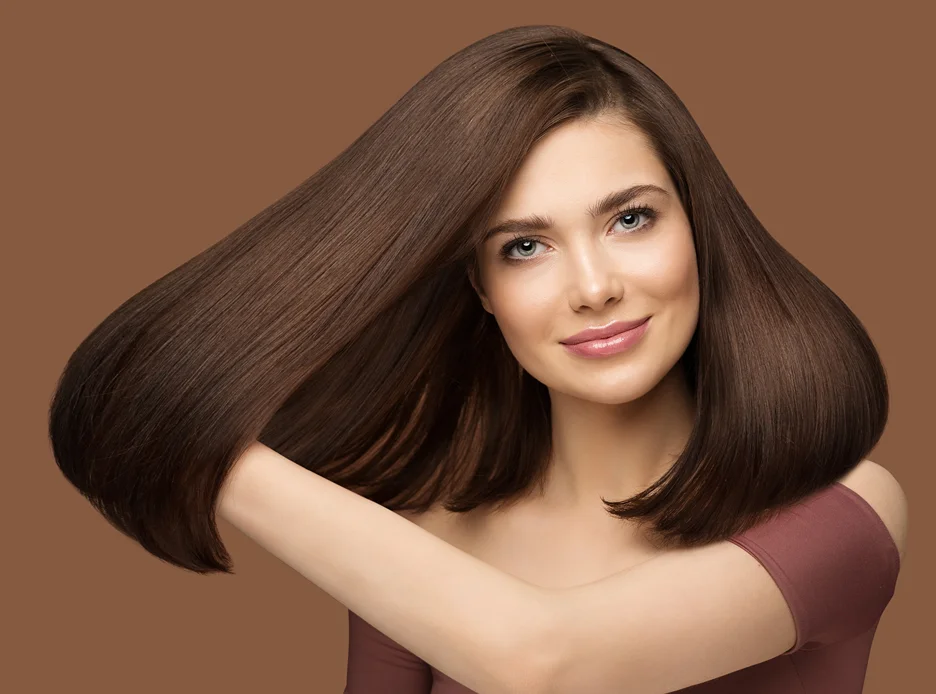
If you’re interested in easily and affordably adding medical grade derma rolling to your hair regrowth regimen, check out FACE Med Store’s Derma Rollers plus Hyaluronic Acid Serum available at an exclusive price for practitioners.
Our derma rollers are designed for simple at-home use and paired with a premium HA formula to enhance results. Support scalp health, boost density, and slow further hair loss safely. We stand behind the quality of our dermarollers and guarantee your satisfaction.

